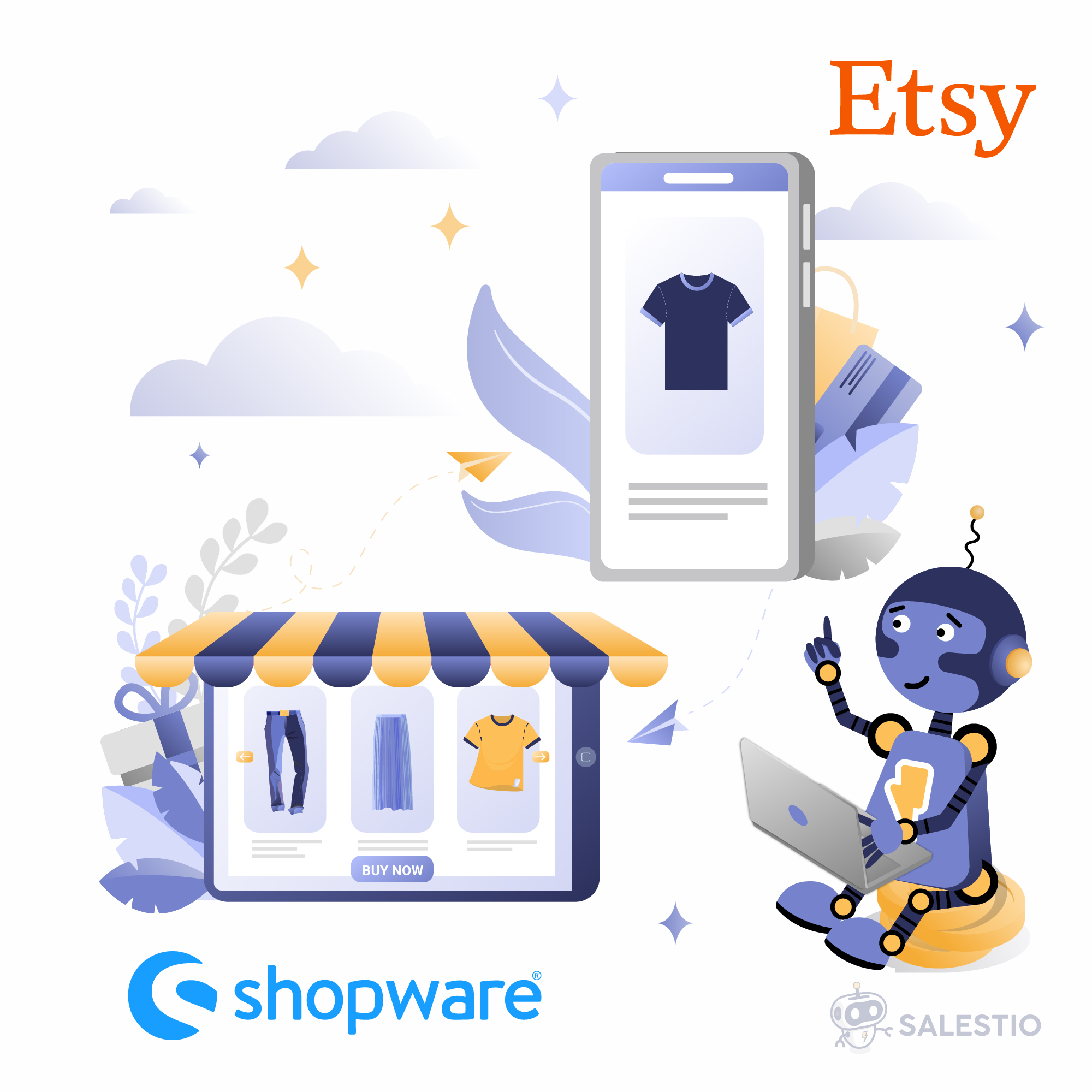05 Jul'24

Today we would like to give you a detailed guide on exporting Shopware products to the eBay marketplace. To do this we will use our Shopware application — Salestio – Amazon, eBay, Etsy Integration
Add an eBay account
Start by adding your eBay account to Salestio. To do so, navigate to the Accounts tab and click the “Add eBay account” button.

For the account name, pick any that you will like and recognize. For the marketplace, select your primary one. Please note that the marketplace selection here will not limit your options for listing items on eBay. It is only used to connect already existing items.
Related: Connect existing eBay/Etsy listings and send new products with Salestio
Set up price and quantity rules
Salestio will send your products with the same prices and quantities as in the Shopware store by default. If you want to customize this, edit your Global Profile in the Profiles tab. Salestio comes with a Default profile pre-configured. You can edit this it or add a new one.

Check the example above. With this profile, Salestio will sync item quantity, but the stock on eBay will cap at 5 pieces. If lower, it will be the same as in Shopware. The price will also be multiplied by 1.2, so a 20% markup.
Related: check out this article with advanced options for syncing quantities
Set up the Creation Profile
Creation Profiles in Salestio define the marketplace categories that your Shopware products should use. Most of the product specifics are also defined here. A Creation Profile is required to list new items through Salestio. To add one, navigate to the Salestio > eBay > Profiles > Creation profiles and click the “Add Creation profile” link.

In the new Creation Profile, pick an appropriate name and eBay marketplace, and move on to adding mappings. A mapping provides a way to place Shopware products in the selected eBay category and provide additional attributes to the product. Select the Shopware product group in the Condition section, and the corresponding eBay category in the Category section.
There are 2 types of mapping conditions in Salestio — Product Type and Category. Depending on the Shopware product page values and needed configuration, you can select any of them or even combine them. Then you will be able to select the needed Category for your products. See an example configuration for pants below.

Below the eBay category, you can find the list of fields. These are the attributes that give your buyers more understanding of your products. Some fields are required and some are optional depending on the product type. In our example, the required fields are the Item Condition, Brand, and Product type.
On eBay, these attributes are usually called Item Specifics.

You can add multiple mappings to the Creation Profile, just keep in mind that mapping conditions should be unique for each mapping. Click “Add new mapping” at the bottom after filling out the details for each one.
Once all desired mappings are added, remember to save the Creation Profile. To do so, just click the ‘Add Profile’ button, or the ‘Save Changes’ button if you are at the point of editing the Creation Profile.
Add an Ebay Profile
Creating an Ebay Profile is an optional step. Creating one offers a way to have a template of settings that you can quickly apply to multiple Selling Lists. If you skip this step, the same information can be specified directly in the Selling List settings in the next section. You can also save the information from a Selling List into a new template to reuse it later. This new template will appear in your Ebay profiles tab.
Here you can select the marketplace, listing type (auction or fixed price), duration (1, 3, 5, 7, 10, GTC), image settings, “shipped from” location, and product dimensions that allow calculating shipping.
At this point, we support only the Fixed Price listing type and GTC (Good Till Canceled) listing duration. The other options are coming in an update soon!
Remember to select the Creation Profile. The list of available Creation Profiles will be shown after the marketplace is selected. More on Creation Profile in the next section.

When done, click the Add profile button at the bottom, and the new profile will be available for selection in Selling List settings. If you want to sell on multiple eBay marketplaces, make sure to add a profile for each one.
Create a Selling List
Selling Lists keep track of the products that you are syncing. Here you will add new items and check the status of existing ones. To create a new Selling List in Salestio, navigate to the Selling Lists tab and click the ‘Add Selling List’ button. On this page, we will put together all the profiles configured in earlier steps.
Pick a name for this Selling List, select the eBay account added on the first step, and move on to the other options.
Pick a Selling List mode: Category or Product.
– In Category mode, Salestio will populate the list with products automatically based on the selected collections from your Shopware store. If an item is removed from a selected category, it will also be removed from the Selling List. This mode also gives the option to send items to eBay automatically when they are added to the Selling List (checkbox “Automatically export new products to Ebay”).
– In Product mode, you pick each product manually. There is also the option to add items in bulk from selected categories. The difference from collection mode is that the products are added once, and will stay until you remove them.

The next step is selecting the marketplace and profiles that we configured earlier. Your Ebay profile and Creation profile are tied to the marketplace, so make sure to pick the right one.

Lastly, you should add Business Policies. This is a set of rules that define available Payment options, Shipping, and Return Policies for buyers.
Business Policies are available depending on the selected marketplace. If none of the policies are displayed after you select the marketplace, go to your eBay account, and make sure that these policies are added specifically for this marketplace.
At this point, Salestio can only show those policies that are added to your eBay account. If you have not yet added any policies, please add them directly to your eBay account. After that, they will be available to select when you create a new Selling List.
When all is set, click the “Add Selling List” button to save the changes.
Export the items to eBay
If you selected Category mode and some Shopware categories earlier, give the app a few minutes to fetch the items. When using Product mode, click the buttons at the top to add new items, individually or in bulk by categories.

When the products are added, select them in the list and click “Send to eBay”:

In a few moments, the status of the products will change from Not Linked to Linked. When a product is listed, the “View on Ebay” link will activate, so you can check your work by clicking it.
Related: check out this article to better understand product statuses in Salestio
And that is a job well done. From now on, Salestio will keep working in the background to update each item in the Linked status. New price and quantity information will be uploaded to eBay whenever any prices change or some items are sold.
Common errors
When encountering a Linking Error status on some of your items, try checking the log messages to quickly find out what the issue is. We will list some of the most common messages and solutions below. After the error is resolved, select the product and click Send to Ebay again.

Ebay category not found
If there is a mistake in the Creation Profile, you might see the message below:
Ebay category not found for product, please adjust Creation ProfileIt means that no mappings correspond to the Shopware category or product type of this item. To resolve this, check if you have product creation enabled in the Selling List settings or the Ebay profile.
Also, check if the mapping condition (Product Type or Category) corresponds to the product that you are trying to send.
Invalid quantity
By default, eBay supports listing products only with positive qty. If you are sending out-of-stock products, this error might appear:
The quantity must be a valid number greater than 0If you would like to list items with 0 qty, consider changing the settings on your eBay account to use Out-of-stock control.
Another option is to stop eBay listing when it reaches 0 qty through the Selling List. For automatic action, update Salestio > Settings > eBay account-related settings.
Location error
Error during submitting a product to eBay. Please add the Item LocationLocation is always required for your listings. You can add the location in the Ebay profile. If you skipped Ebay profiles, this information can be added directly in the Selling List settings, Ebay profile section.
Try the app
Salestio streamlines the process of managing an eBay store. After the above process is done, you can rely on automatic updates. And when the time comes to list more items, they can be added to existing Selling Lists with no extra hassle. Ready to try it on your store? Salestio offers a 30-day free trial which you can start today by getting the app from The Shopware Store.





